#Megapodius
Text
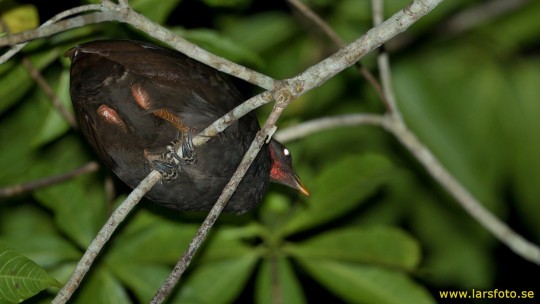
[769/10,977] Biak Scrubfowl - Megapodius geelvinkianus
Also known as: Biak Megapode
Order: Galliformes
Family: Megapodiidae (megapodes)
Photo credit: Lars Petersson via Macaulay Library
13 notes
·
View notes
Text
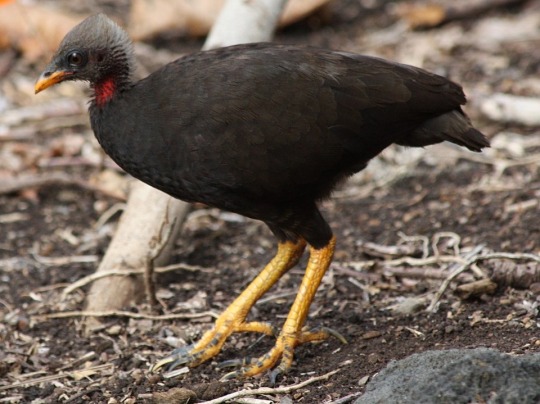
Range: Certain islands of the Northern Mariana Islands
#poll#Class: Aves#Order: Galliformes#Family: Megapodiidae#Genus: Megapodius#Megapodius Laperouse#Range: Australasian
20 notes
·
View notes
Text

October 31, 2022 - Micronesian Megapode (Megapodius laperouse)
Found in the Northern Mariana Islands and Palau, these small megapodes live in forests, coconut groves, coastal scrub, and rocky areas. They eat spiders, insects, snails, seeds, small fruit, and other plant foods, foraging on the forest floor, usually in pairs. Depending on the subspecies, they nest in burrows or build mounds. Females dig the burrows in areas heated by the sun or geothermal sources, often near fallen or live trees. Both parents build the mound nests mostly from leaf litter and sand. They are classified as Near Threatened by the IUCN due mostly to habitat loss from sea level rise and forest clearance, human disturbance, and invasive species.
65 notes
·
View notes
Text

#i haven't posted one of these in ages#i still have so many to share#anyways i see so many of these guys but they are always very cute and funny#camera trap#orange-footed scrubfowl#creature#also i know their scientific name off by heart now:#megapodius reinwardt
1 note
·
View note
Text
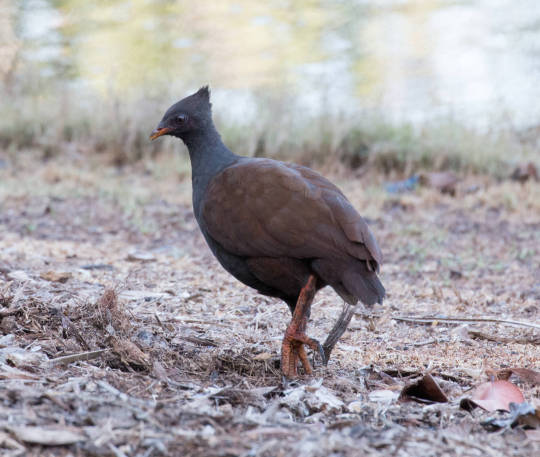
Orange-footed scrubfowl (Megapodius reinwardt) by Hix
2 notes
·
View notes
Text
every article ive seen about Megapodius reinwardt seems to talk abou the mound like its some sort of revered and highly praised dwelling
0 notes
Text
TURISIAN.com – Wisata ke Maluku wajib singgah di Kabupaten Seram Bagian Barat. Di sana banyak objek wisata alam yang memesona. Salah satu yang menarik Sobat Turisian kunjungi, yaitu Pulau Kassa.
Kassa merupakan salah satu pulau tak berpenghuni dan memiliki hamparan pasir putih yang mengelilingi pulau dengan pemandangan yang indah dan alami. Saat berada di sini, Sobat Turisian memanjakan mata dan menenangkan pikiran.
Tak hanya itu, keunikan Pulau Kassa juga memiliki beberapa potensi flora dan fauna yang menarik buat menambah wawasan Sobat Turisian. Untuk flora, ada Anggrek Bulan Ambon, Cemara laut, Waru Laut, dan Beringin Pantai.
Di pulau yang termasuk kawasan dilindungi ini, terdapat pula kekayaan fauna endemik Maluku. Seperti Biawak Ambon (Varanus indicus), Soa-soa (Hydrosaurus amboinensis), Burung Gosong (Megapodius reinwardtii), dan Kus-kus (Phalanger sp.).
Selain satwa tersebut, di Pulau Kassa juga terdapat beberapa jenis burung dilindungi. Di antaranya Elang Laut Perut Putih (Haliaeetus leucogaster), Raja Udang Pantai (Halcyon saurophaga), Gegajahan Besar (Numenius arguata orientalis). Serta jenis lainnya, seperti Burung Pombo Biru Dada Putih (Ducula bicolor) dan Burung Ekor Kipas (Rhipidura sp.).
Baca juga: Air Terjun Waisia Rumakay Pesona Alam dari Seram Bagian Barat
Ada lagi berbagai jenis biota laut yang ada di wilayah perairannya, antara lain Kima Raksasa, Kima Sisik, Kima Cina. Tambah lagi Triton Terompet, Koral Lunak, Koral Bulu Ayam, Koral Kuping (Echinophora sp.), Koral Otak. Lalu Koral Jamur, Mimi, Ikan Botana Biru, Ikan Bendera, dan Ikan Biji Nangka.
Daya Tarik Wisata Pulau Kassa
Objek wisata bahari di Kabupaten Seram Bagian Barat ini, selain mengenal flora dan fauna, juga bisa melakukan berbagai aktivitas wisata. Sobat Turisian bisa mencoba menyelam, snorkeling, dan wisata minat khusus lainnya.
Sobat Turisian pecinta selfie juga bisa terpuaskan di Pulau Kassa. Di sini terdapat berbagai spot foto yang ciamik dan tentunya instagrammable banget. Spot favoritnya berupa jembatan sepanjang 150 meter yang menjorok ke laut. Berfungsi sebagai dermaga kecil untuk jalur Sobat Turisian menuju pulau saat turun dari kapal.
Lokasi & Akses ke Pulau Kassa
Destinasi pulau ini terletak 22 km dari Piru tepatnya di Desa Kaibobu, Kabupaten Seram Bagian Barat, Maluku. Memiliki luas area 1100 hektar dengan fasilitas pendukung, di antaranya cottage, tambatan perahu, jalan setapak, jembatan 150 meter, dan lainnya.
Untuk menuju Pulau Kassa, Sobat Turisian dapat menempuh dengan jalan darat dari Ambon menggunakan Bus Antar Kota Dalam Provinsi. Atau angkot ke Desa Liang (Dermaga Ferry Hunimua) selama kurang lebih 1 hingga 1,5 jam.
Baca juga: Menelusuri Jejak Sejarah di Benteng Wantrouw Maluku
Dari situ lanjut dengan penyeberangan Ferry ke Waipirit selama sekitar 2 sampai 2,5 jam. Kemudian teruskan perjalanan darat ke Desa Piru untuk naik perahu (sampan) menuju ke lokasi. Selain itu dapat juga melalui jalur laut langsung dari Desa Hitu menuju ke sana atau dari Desa Tulehu langsung ke lokasi makai speed boat dalam waktu sekira 1,5 jam perjalanan.*
Sumber: BKSDA Maluku
0 notes
Photo
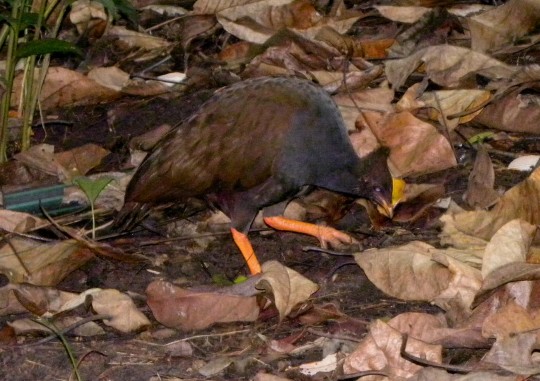
Orange-footed scrubfowl (Megapodius reinwardt)
Photo by Charles Cuthbert
#orange footed scrubfowl#scrubfowl#megapodius reinwardt#megapodius#megapodiidae#galliformes#galloanserae#neognathae#aves#theropoda#archosauria#sauropsida#reptilia#tetrapoda#vertebrata#chordata
13 notes
·
View notes
Photo
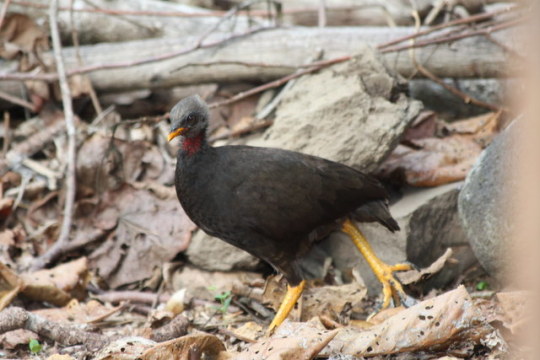
Megapodius laperouse by Michael Lusk
#bird#birds#animal#animals#biology#nature#wildlife#fauna#Galliformes#Megapodiidae#Megapodius#Megapodius laperouse
46 notes
·
View notes
Text
Megapodius

Orange-Footed Scrubfowl, M. reinwardt, by Bernard Dupont, CC BY-SA 2.0
PLEASE SUPPORT US ON PATREON. EACH and EVERY DONATION helps to keep this blog running! Any amount, even ONE DOLLAR is APPRECIATED! IF YOU ENJOY THIS CONTENT, please CONSIDER DONATING!
Name: Megapodius
Status: Extant
First Described: 1823
Described By: Gaimard
Classification: Dinosauria, Saurischia, Eusaurischia, Theropoda, Neotheropoda, Averostra, Tetanurae, Orionides, Avetheropoda, Coelurosauria, Tyrannoraptora, Maniraptoriformes, Maniraptora, Pennaraptora, Paraves, Eumaniraptora, Averaptora, Avialae, Euavialae, Avebrevicauda, Pygostylia, Ornithothoraces, Euornithes, Ornithuromorpha, Ornithurae, Neornithes, Neognathae, Galloanserae, Pangalliformes, Galliformes, Megapodiidae
Referred Species: M. pritchardii (Tongan Megapode, Extant), M. laperouse (Micronesian Megapode, Extant), M. nicobariensis (Nicobar Megapode, Extant), M. cumingii (Philippine Megapode, Extant), M. bernsteinii (Sula Megapode, Extant), M. tenimberensis (Tanimbar Megapode, Extant), M. freycinet (Dusky Megapode, Extant), M. geelvinkianus (Biak Scrubfowl, Extant), M. eremita (Melanesian Megapode, Extant), M. layardi (Vanuatu Megapode, Extant), M. affinis (New Guinea Scrubfowl, Extant), M. reinwardt (Orange-Footed Scrubfowl, Extant), M. molistructor (Pile-Builder Scrubfowl, Extinct), M. amissus (Viti Levu Scrubfowl, Extinct)

Micronesian Megapode, M. laperouse, by Michael Lusk, CC BY-SA 2.0
Megapodius is, by far, the largest genus of Megapodes, with many species making up its genus. Most of these species are alive today, though there are two distinct extinct ones as well. These birds are commonly called Scrubfowl, and, like all Megapodes, are distinctly unique due to their highly specialized method of egg incubation. M. molistructor, the Pile-Builder Megapode, is an extinct species from New Caledonia and Tonga, known from only about 12,000 years ago on, in the Holocene of the Quaternary. Weighing about 3.5 kilograms, it was the heaviest species in this genus, and one of the largest ground-dwelling birds of the islands it lived on. This bird probably went extinct due to the arrival of human settlers about 3500 years ago. The other extinct Speices, M. amissus, the Viti Levu Scrubfowl, was a Megapode known from Fiji during the Holocene, about the size of the Orange-Footed Scrubfowl, though with more robust legs and reduced wings, indicating flightlessness. It, too, went extinct due to overhunting and other human activity.
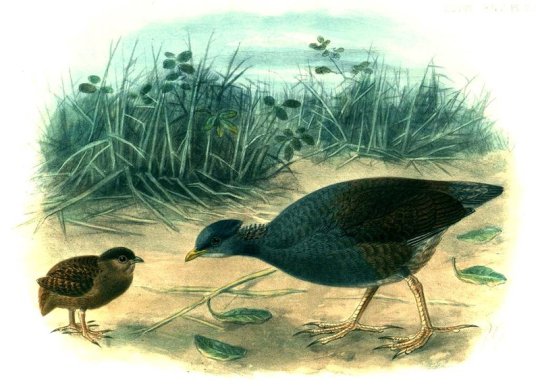
Tongan Megapode, M. pritchardii, by Walter Lawry Buller, in the Public Domain
The Tongan Megapode is an endangered species known from Tonga, the only remaining species of Megapode still known from these islands, even though multiple species were present prior to the arrival of humans. Their remote habitat made populations of these birds vulnerable to human activity. They live primarily in tropical lowland forests, and they use the warm volcanic soil of their habitats to incubate their eggs. The baby birds are able to fly immediately upon hatching. These birds are threatened due to human hunting and habitat reduction.
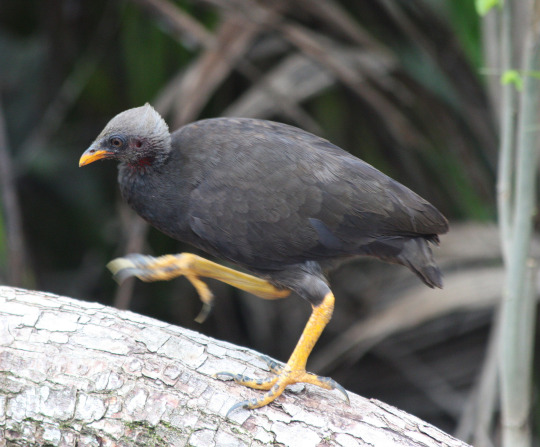
Micronesian Megapode, M. laperouse, by Michael Lusk, CC BY-SA 2.0
The Micronesian Megapode is another endangered species, about 38 centimeters in length, from the Marianas Islands. Medium-sized birds, they have pale heads, dark bodies, and bright yellow legs. They are usually found in thickets and lowland scrub, and they’re very shy and secretive. They breed after the monsoon season and make large mounds of debris to lay their eggs, sometimes multiple females using the same mound. They are protected, but the introduction of mammalian predators have greatly reduced their populations.
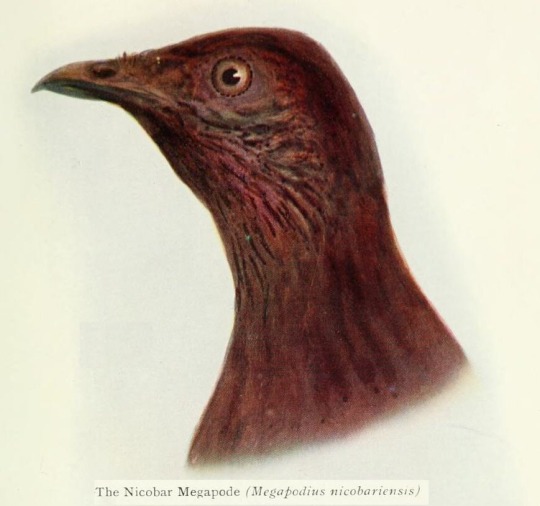
Nicobar Megapode, M. nicobariensis, by R. W. Shufeldt, in the Public Domain
The Nicobar Megapode is a vulnerable species known from the Nicobar Islands of India. It builds large nest mounds, like the other species in this genus; but are very secretive in how they do so - they primarily build mounds near the coast with coral sand and plant material, and the mounds are often reused. The young birds are fully feathered, and can fly as soon as their feathers dry up. They mainly move around in thick jungle during the day, and go out onto the shore of the ocean at night, mainly walking in small groups or pairs. They eat both plant and animal material, ingesting grit to aid in digestion. They are brownish birds, and are primarily threatened due to habitat loss and human activity.

Philippine Megapode, M. cumingii, by Jason Thompson, CC BY 2.0
The Philippine Megapode, which is such a little cutie, is a non-threatened species found in the Philippines, Borneo, and Sulawesi, mainly in dry forest, moist lowland forest, and mountain forests.

Sula Megapode, M. bernsteinii, by Huub Veldhuijzen van Zanten, CC BY-SA 3.0
The Sula Megapode, is a vulnerable species known on the Banggai and Sula Islands in Indonesia, primarily in tropical and subtropical forest, both dry and wet, as well as mangrove forests. As such, it is extensively threatened with habitat destruction. These birds are reddish brown, with short pointed crests, and they grow up to 35 centimeters in length. They forage in pairs, or sometimes small groups, mainly on roots and invertebrates. They perform mating dances, to an extent, where all the birds call out together, and then build cone-shape mounds over rotting vegetation to keep the eggs warm. The Tanimbar Megapode, M. tenimberensis, on the other hand, is a near-threatened species from the Tanimbar Islands of Indonesia, about the size of a domestic chicken. It’s primarily found in forest and scrubland, and feeds on fallen fruit, seeds, and invertebrates.

Dusky Megapode, M. freycinet, by Nicolas Huet, in the Public Domain
The Dusky Megapode, is a 41 centimeters long black bird with a short pointed crest and red facial skin. They look similar across the sexes, and build mounds made of leaves, sand, gravel, and sticks, as large as 11 meters in diameter. They are very common birds and not considered currently threatened with extinction.
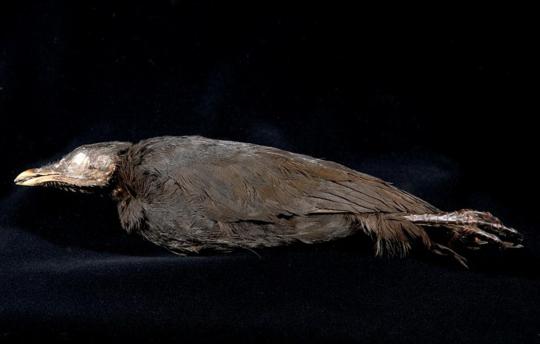
Biak Scrubfowl, M. geelvinkianus, by Huub Veldhuijzen van Zanten, CC BY-SA 3.0
The Biak Scrubfowl is a vulnerable species known from islands in West Papua, Indonesia, measuring about 36 centimeters in length, with dark grey feathers and a blueish face. They live in lowland tropical forests and some shrublands, which has lead to its threatened position due to habitat loss.
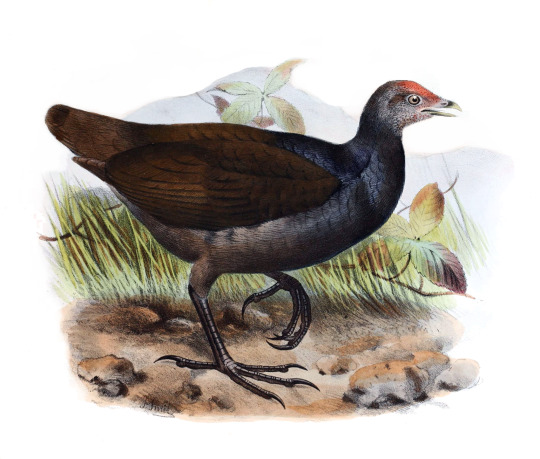
Melanesian Megapode, M. eremita, by Joseph Smit, in the Public Domain
The Melanesian Megapode is a nonthreatened scrubfowl species from Papua New Guinea and the Solomon Islands, living in tropical lowland forests and some mountain forests. It has brown and blue feathers, and a red patch on its head.

Vanuatu Megapode, M. layardi, by W. R. Ogilvie-Grant, in the Public Domain
The Vanuatu Megapode is a vulnerable species known from the island of Vanuatu, living in subtropical and tropical lowland forest. Unfortunately, it’s threatened by habitat loss and egg hunting. The New Guinea Scrubfowl, N. decollatus, on the other hands, is a poorly studied nonthreatened Megapode from tropical lowland forests and mountain forests in New Guinea, but unfortunately it isn’t very well documented.
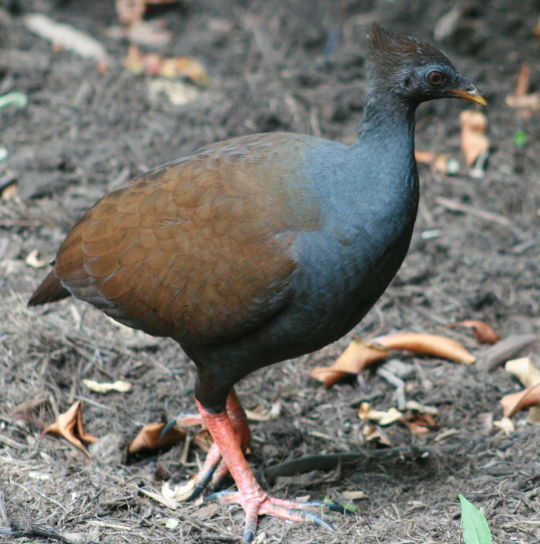
Orange-Footed Scrubfowl, M. reinwardt, by Toby Hudson, CC BY-SA 3.0
Finally, the Orange-Footed Scrubfowl is a non-threatened species from the Sunda Islands, New Guinea, and Australia. The size of a chicken, it has brown and blue feathers, with orange feet, hence its name. They also have distinctive pointy crests. They live in forest and scrubland habitat, and make mounds of sand and leaf litter that can reach up to 4.5 meters in height. They mainly eat seeds, fallen fruit, and some invertebrates.
Buy the author a coffee: http://ko-fi.com/kulindadromeus
Sources:
https://en.wikipedia.org/wiki/Scrubfowl
https://en.wikipedia.org/wiki/Pile-builder_megapode
https://en.wikipedia.org/wiki/Viti_Levu_scrubfowl
https://en.wikipedia.org/wiki/Tongan_megapode
https://en.wikipedia.org/wiki/Micronesian_megapode
https://en.wikipedia.org/wiki/Nicobar_megapode
https://en.wikipedia.org/wiki/Philippine_megapode
https://en.wikipedia.org/wiki/Sula_megapode
https://en.wikipedia.org/wiki/Tanimbar_megapode
https://en.wikipedia.org/wiki/Dusky_megapode
https://en.wikipedia.org/wiki/Biak_scrubfowl
https://en.wikipedia.org/wiki/Melanesian_megapode
https://en.wikipedia.org/wiki/Vanuatu_megapode
https://en.wikipedia.org/wiki/New_Guinea_scrubfowl
https://en.wikipedia.org/wiki/Orange-footed_scrubfowl
#megapodius#scrubfowl#megapode#dinosaur#chicken#pheasant#birblr#palaeoblr#megapodius pritchardii#tongan megapode#megapodius laperouse#micronesian megapode#megapodius nicobariensis#nicobar megapode#megapodius cumingii#philippine megapode#megapodius bernsteinii#sula megapode#megapodius tenimberensis#tanimbar megapode#megapodius freycinet#dusky megapode#megapodius geelvinkianus#biak scrubfowl#megapodius eremita#melanesian megapode#megapodius layardi#vanuatu megapode#megapodius affinis#new guinea scrubfowl
45 notes
·
View notes
Photo

Pictures just as guidance..work to come Tampah hills is naturally a tropical dry to semievergreen forest at 8 degrees south, inside the tropical zone. As such we dont get natural fires much. Places like Australia burn so much because they get dry lightning storms that ignite vegetation naturally. Here its almost all from human activity. The natural vegetation here is supremely conserving of humidity and rarely burns of its own accord, and the flora and fauna rapidly decay the litter back to the soil. Only a thin layer is maintained all year. When Orange footed scrubfowl (Megapodius reinwardtii) and Green junglefowl/ ayam hutan (Gallus varius) were more abundant, their moundbuilding nests and scratching would have accelerated litter decomposition. But today we have a severely damaged landscape. The scrubfowl are gone, the Junglefowl pushed back to high refuges. The often burnt landscape has proliferated with regrowth and fire weeds like Blady grass / alang alang (Imperata cylindra). This creates a substantial fire risk to our project. As we start stage one and two with 40 plots already sold, we are making fire control our priority. Now and forever. We have permanent solutions on the horizon but till then; Firebreaks, rapid response mobile fire units, selective pruning and blady grass eradication, fuel reduction, cessation of hunting. On march 4 we begin our annual fire month. March, Mars, Aries, we temper that hot temper of war and destruction. All hands on deck to clear a 15m firebreak and then reduce and localise fuel on our southern slopes We will remove all fuel 15m from our boundaries with firebug farmer neighbours and keep it clear till next rainy season. They love to burn cropwastes, i hope we can illuminate methods to turn a quid from those without burning., composts, mushrooms, chickens.. We have a few strategies to try out but this comes first. We will update as we implement others #tampahhills #safety #fire #ecology #lombok #invest #development #liad #bestpractice #firebreak #megapodius #gallusvarius https://www.instagram.com/p/BuQdI3XAxXM/?utm_source=ig_tumblr_share&igshid=1s46a3cuvb2y7
#tampahhills#safety#fire#ecology#lombok#invest#development#liad#bestpractice#firebreak#megapodius#gallusvarius
0 notes
Text
Bumbanipodius magnus Zelenkov, 2021 (new genus and species)

(Type tarsometatarsus [fused ankle and foot bones] of Bumbanipodius magnus, from Zelenkov, 2021)
Meaning of name: Bumbanipodius = Bumban Member scrubfowl (genus Megapodius); magnus = big
Age: Eocene (Ypresian)
Where found: Naran-Bulak Formation, Ömnögovi, Mongolia
How much is known: A partial left tarsometatarsus (fused ankle and foot bones) and a partial left coracoid (shoulder bone). (It is not known whether both bones belong to the same individual.)
Notes: Bumbanipodius was a galliform, a group that also includes chickens, quails, and turkeys. It differed from most other galliforms in having a short bump on the inner edge of its tarsometatarsus for ligament attachment, though a similar feature is also known in extant scrubfowl. Bumbanipodius was larger than Bumbanortyx, another early galliform found at the same locality, but at the size of a typical American quail, it was still relatively small by galliform standards.
Reference: Zelenkov, N.V. 2021. New bird taxa (Aves: Galliformes, Gruiformes) from the early Eocene of Mongolia. Paleontological Journal 55: 438–446. doi: 10.1134/S0031030121040158
11 notes
·
View notes
Photo

November 13, 2017 - Orange-footed Scrubfowl or Orange-footed Megapode (Megapodius reinwardt)
These megapodes are found in parts of Indonesia, New Guinea, and northern Australia. They eat mostly plant foods, including seeds, berries, roots, fruits, shoots, and flowers, along with some invertebrates and small vertebrates. Breeding during and after rains, they build large nest mounds, using the heat produced by decaying plant material to incubate their eggs. The chicks dig themselves out of the mounds after hatching and are developed enough to run immediately and fly very short distances soon after.
#orange-footed scrubfowl#scrubfowl#megapode#megapodius reinwardt#bird#birds#illustration#art#tropical#birblr art
56 notes
·
View notes
Photo

Orange-footed scrubfowl. 🔎 (Megapodius reinwardt). ⏳ Conservation Status: Least Concern. Population stable. 🗺 Endemicity: Australia, Indonesia, Papua New Guinea, Timor-Leste. 📷 Wonga Beach, Queensland. – – #orangefootedscrubfowl #scrubfowl #birdsofaustralia #australia #queensland #wettropics #birdsofinstagram #naturephotography #birdsofthetropics #birds #birdphotography #thewettropics #nature #photography #birdwatching (at Wonga Beach) https://www.instagram.com/p/Boy0BQXhXuk/?utm_source=ig_tumblr_share&igshid=1b18n7p14gp8z
#orangefootedscrubfowl#scrubfowl#birdsofaustralia#australia#queensland#wettropics#birdsofinstagram#naturephotography#birdsofthetropics#birds#birdphotography#thewettropics#nature#photography#birdwatching
1 note
·
View note
Note
Are there any flightless Galliformes (not counting some breeds of domestic turkeys)?
There aren’t any extant, wild galliforms that are flightless as adults. However, the recently extinct Viti Levu megapode (Megapodius amissus) was probably flightless or nearly so, as was probably also the case with the quails Coturnix alabrevis, C. centensis, and C. lignorum. There were also Sylviornis and Megavitiornis, two recently extinct flightless birds that are currently thought to have been stem galliforms.
0 notes
Text
https://www.napimagazin.hu/a-melytengeri-hidrotermalis-kurtoket-hasznalja-keltetokent-egy-rajafele/
New Post has been published on https://www.napimagazin.hu/a-melytengeri-hidrotermalis-kurtoket-hasznalja-keltetokent-egy-rajafele/
A mélytengeri hidrotermális kürtőket használja keltetőként egy rájaféle

A mélytengeri hidrotermális kürtők szomszédságában rakja le tojásait egy rájaféle, hogy az átlagosnál melegebb vizet kihasználva felgyorsítsa az egyébként négy vagy akár még több évig eltartó keltetési folyamatot – derült ki egy új tanulmányból, amely elsőként szolgál bizonyítékkal arra, hogy egy tengeri teremtmény vulkanikus hővel kelteti a tojásait.
A valódi rájafélék közé tartozó Bathyraja spinosissima faj tojástokkal körülvett ivadékai leginkább egy méretes raviolira hasonlítanak, amelyet mind a négy sarkán apró nyúlványok zárnak le. A már kiürült tojástokokat, amelyeket gyakran partra sodor a víz, a “sellők pénztárcájaként” is szokták emlegetni.
Az ivadékok éveket töltenek a vízáteresztő kollagénburokban: legkevesebb 1500 napot, ha a körülöttük lévő víz átlaghőmérséklete 2,7 Celsius-fok – írja a LiveScience című ismeretterjesztő hírportál.
Azért, hogy jobban megismerjék a több mint 3000 méteres mélységben élő rájafaj és környezetének kapcsolatát, a kutatók egy hidrotermális kürtőkben gazdag területet vizsgáltak át a Csendes-óceán Galápagos-szigetekhez közel eső részén. A hidrotermális kürtők leggyakrabban az óceáni hátságok közelében, az óceánok fenekén alakulnak ki, amikor a repedésekben a forró magma felhevíti a vizet, amely aztán a magas hőmérsékleten sok ásványi anyagot old ki.
A kutatást vezető Pelayo Salinas de León, az ecuadori Charles Darwin Alapítvány ökológusa és kollégái egy távirányítású járművel térképezték fel a területet, ahol ráját ugyan nem, de összesen 157 tojástokot találtak, amelyek többsége – 58 százaléka – pontosan 20 méterre helyezkedett el a legforróbb kürtőktől. A Nature című tudományos folyóirat internetes kiadásában közölt tanulmány szerint az ilyen területeken tapasztalható melegebb – az egyik területen például 4,5 Celsius-fokos – víz felgyorsíthatja a keltetési időt.
A valódi rájafélék a porcos halak osztályába tartoznak, amelyek a túlhalászat elsődleges áldozataivá váltak az utóbbi évtizedekben. Az ide tartozó fajok immár nagyjából 25 százalékát fenyegeti a kihalás. A mélytengeri környezetben élő fajok különösen veszélyeztetett helyzetben vannak, mivel általában lassabban fejlődnek és később válnak ivaréretté, ami jelentősen megnehezíti a regenerálódást a megtizedelt populációk számára.
A kutatók szerint a szárazföldi állatoktól korántsem idegen, hogy a környezetükben lévő vulkanikus tevékenységet kihasználva “begyújtanak a tojásaik alá”. Az állati fosszíliák tanúsága szerint a kréta földtörténeti korban élő szauropoda dinoszauruszok egy része a vulkáni tevékenység révén felmelegedett földbe ásta el a tojásait. A ma élő tongai ásótyúk (Megapodius pritchardii) ugyancsak a vulkánok által felmelegített talajba készít fészket magának. Soha ezelőtt nem találtak azonban még arra utaló bizonyítékot, hogy egy tengeri teremtmény vulkanikus hővel kelteti a tojásait.
A kutatók szerint ezen mélytengeri teremtmények szaporodási szokásainak és természetes élőhelyeinek jobb megismerése kulcsfontosságú ahhoz, hogy hatékony stratégiákat dolgozhassanak ki megóvásukra.
0 notes